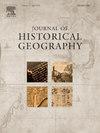Cartographic Reproductions: The Franciscan Legacy in Amazonian Peru, 1830–1847
IF 1.3
2区 历史学
Q2 GEOGRAPHY
引用次数: 0
Abstract
Scholars have not paid sufficient attention to the role that cartographic reproduction played in shaping and disseminating geographic knowledge about Amazonia in early postcolonial Peru. By the early nineteenth century, when Peru gained its independence from Spain, cartographic knowledge of its eastern Amazonian frontier was limited to maps produced mostly by Franciscan missionaries who had overseen the evangelization of the region since the previous century. Thus, the reproduction of missionary charts became an important procedure that the Peruvian administration undertook to delineate and incorporate Amazonia into the newly independent nation. But it was not a simple process of copying, nor was it associated with advances in technical and printing accuracy, the reduction of map production costs, and the emergence of copyright regulations, as has been commonly argued in studies of modern cartographic copying. In contrast, this article explores a still unregulated context involving amateur cartographers who produced primarily handwritten maps. More significantly, I highlight the new meanings that colonial missionary maps acquired after being reproduced within postcolonial bureaucratic circles through the deployment of three strategies of cartographic reproduction — celebratory, tactical-military, and administrative — that transformed the original evangelizing intentions that the Franciscans had when mapping Amazonia.
地图复制品:方济会在亚马逊秘鲁的遗产,1830-1847
学者们对地图复制在塑造和传播早期后殖民时期秘鲁亚马逊地区地理知识方面所起的作用没有给予足够的重视。到19世纪初,秘鲁从西班牙独立出来时,对亚马逊东部边境的地图知识主要局限于方济会传教士制作的地图,这些传教士自上个世纪以来一直监督该地区的福音传播。因此,复制传教地图成为秘鲁政府划定亚马逊地区并将其纳入新独立国家的一项重要程序。但这不是一个简单的复制过程,也与技术和印刷精度的进步、地图制作成本的降低以及版权法规的出现有关,这些都是现代地图复制研究中普遍认为的。相比之下,本文探讨了一个仍然不受监管的背景,涉及主要制作手写地图的业余制图师。更重要的是,我强调了殖民传教士地图在后殖民官僚圈内复制后获得的新意义,通过部署三种制图复制策略-庆祝,战术-军事和行政-改变了方济各会在绘制亚马逊地图时最初的福音传播意图。
本文章由计算机程序翻译,如有差异,请以英文原文为准。
求助全文
约1分钟内获得全文
求助全文
来源期刊

Journal of Historical Geography
Multiple-
CiteScore
1.50
自引率
10.00%
发文量
53
期刊介绍:
A well-established international quarterly, the Journal of Historical Geography publishes articles on all aspects of historical geography and cognate fields, including environmental history. As well as publishing original research papers of interest to a wide international and interdisciplinary readership, the journal encourages lively discussion of methodological and conceptual issues and debates over new challenges facing researchers in the field. Each issue includes a substantial book review section.
 求助内容:
求助内容: 应助结果提醒方式:
应助结果提醒方式:


